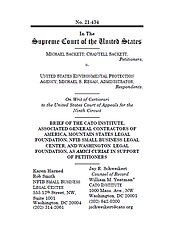Learn more about Cato’s Amicus Briefs Program.
For 50 years, Congress has dodged its responsibility to set clear boundaries on federal authority under the Clean Water Act. The executive branch, alas, has further muddied the waters: every time there’s a political changeover in the White House, the limits of federal jurisdiction undergo a president‐led transformation. Thus, the regulatory reach of the Clean Water Act is a major question that Congress won’t answer and one that agencies can’t answer. As a result, landowners nationwide have been denied regulatory certainty with respect to the enjoyment of their property.
In 2007, Michael and Chantell Sackett became mired in this regulatory morass. Their plans for a family home were put on indefinite hold when the government claimed that soggy parts of their property are “navigable waters” and are therefore subject to federal regulation. The Sacketts, represented by the Pacific Legal Foundation, challenged the government’s jurisdictional determination in federal court, arguing that their homesite—which is bounded by permanent roads on both ends and has no surface water connection to any water body—cannot fall within the Clean Water Act’s ambit. Although the Ninth Circuit sided with the government, the Supreme Court took the case to review whether the Ninth Circuit used the correct test in determining the scope of federal authority to regulate “navigable waters.”
Today, the Cato Institute, joined by the Associated General Contractors of America, the Mountain States Legal Foundation, the NFIB Small Business Legal Center, and the Washington Legal Foundation, filed a brief in support of the Sacketts. We argue that courts have greater expertise than regulatory agencies when it comes to fixing jurisdictional limits on federal authority under the Clean Water Act. Accordingly, we urge the Court to provide landowners with long-needed regulatory certainty.

This work is licensed under a Creative Commons Attribution-NonCommercial-ShareAlike 4.0 International License.


